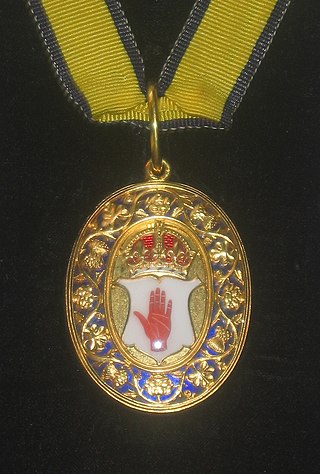
A baronet or the female equivalent, a baronetess, is the holder of a baronetcy, a hereditary title awarded by the British Crown. The title of baronet is mentioned as early as the 14th century; however, in its current usage it was created by James I of England in 1611 as a means of raising funds for the crown.

Marquess of Linlithgow, in the County of Linlithgow or West Lothian, is a title in the Peerage of the United Kingdom. It was created on 23 October 1902 for John Hope, 7th Earl of Hopetoun. The current holder of the title is Adrian Hope.

Baron Farnham, of Farnham in the County of Cavan, is a title in the Peerage of Ireland. It was created in 1756 for John Maxwell, who had previously represented Cavan Borough in the Irish House of Commons. John Maxwell's son, the second Baron, was created Viscount Farnham in 1760 and Earl of Farnham in 1763. Both titles were in the Peerage of Ireland but became extinct when he died childless in 1779. His brother and successor, the third Baron, was again created Viscount Farnham in 1781 and Earl of Farnham in 1785. These titles were also in the Peerage of Ireland. His son, the second Earl, sat in the House of Lords as an Irish Representative Peer from 1816 to 1823. However, he had no children and on his death in 1823 the viscountcy and earldom became extinct.
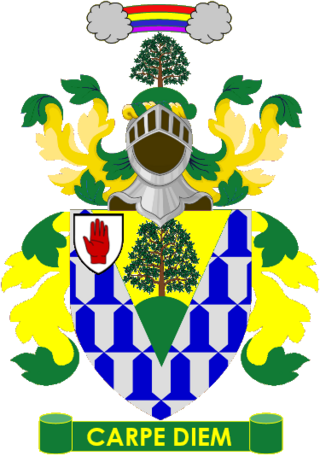
The Wigan Baronetcy, of Clare Lawn in Mortlake in the County of Surrey and Purland Chase in Ross in the County of Hereford, is a title in the Baronetage of the United Kingdom. It was created on 9 March 1898 for Frederick Wigan, a Director of the North London Railway. The presumed 6th Baronet, listed in Debrett's Peerage (2015) as the son of the 5th Baronet, has not successfully proven his succession and is consequently not on the Official Roll of the Baronetage.
There have been five Baronetcies created for people with the surname Forbes, four in the Baronetage of Nova Scotia and one in the Baronetage of the United Kingdom. The first holder of the Burn Baronetcy of Jessfield, created in the Baronetage of the United Kingdom in 1923, assumed the surname of Forbes-Leith of Fyvie in 1925.

There have been four baronetcies created for persons with the surname Hope, three in the Baronetage of Nova Scotia and one in the Baronetage of the United Kingdom. As of 2010 one creation is extant, one dormant and two extinct.
The Dunbar, later Hope-Dunbar Baronetcy, of Baldoon, is a title in the Baronetage of Nova Scotia. It was created on 13 October 1664 for David Dunbar, with remainder to his heirs male and tailzie. The baronetcy became dormant on his death in 1686. The title remained dormant until 1916, when it was successfully claimed by Charles Hope-Dunbar, who became the sixth Baronet. He was a descendant of Mary, granddaughter and sole heiress of the first Baronet. Hope-Dunbar was also the grandson of the Hon. Charles Hope, third son of John Hope, 4th Earl of Hopetoun. Consequently, the present holder of the baronetcy is also in remainder to the earldom of Hopetoun and its subsidiary titles the viscountcy of Aithrie, lordship of Hope and baronetcy of Kirkliston, titles held by his kinsman the Marquess of Linlithgow.
There have been five baronetcies created for persons with the surname Home, four in the Baronetage of Nova Scotia and one in the Baronetage of the United Kingdom. Only one creation is extant as of 2008.
Wigtownshire was a constituency represented in the Parliament of Scotland until 1707.
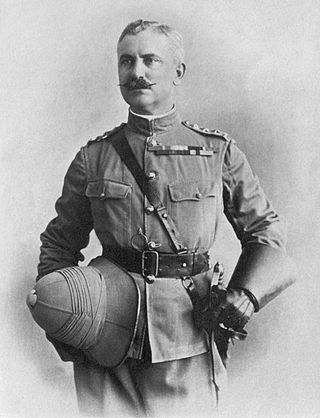
The Wingate Baronetcy, of Dunbar in the County of Haddington and of Port Sudan, was a title in the Baronetage of the United Kingdom. It was created on 6 July 1920 for General Sir Reginald Wingate. He was succeeded by his son, the second Baronet. He was a colonial administrator. The title became extinct on his death in 1978.
The Wishart Baronetcy, of Clifton Hall in the County of Edinburgh, was a title in the Baronetage of Nova Scotia. It was created on 17 June 1706 for George Wishart. Emilia Stuart Belches was heir general of the original grantee and was apparently allowed to succeed to the baronetcy. Assuming she did succeed, she was one of only five female baronets - see also Bolles, Dalyell, Dunbar and Maxwell. The fourth Baronet sat as Member of Parliament for Kincardineshire. The title became dormant on his death in 1821.
Before the Acts of Union 1707, the barons of the shire of Elgin and Forres elected commissioners to represent them in the unicameral Parliament of Scotland and in the Convention of the Estates.
Sir Patrick Dunbar, 3rd Baronet, of Bowermadden, and Northfield, Caithness, was a Scottish politician who sat in the British House of Commons from 1727 to 1734.
Sir William James Thomas, 1st Baronet was a Welsh industrialist and philanthropist. He was knighted in 1914 and created a baronet on 10 May 1919, under the title Baronet Thomas of Ynyshir.

The Dunbar baronetcy, of Mochrum, Wigtownshire, was created for James Dunbar in the Baronetage of Nova Scotia on 29 March 1694. He married, firstly, Isabel Nicholson, daughter of the 2nd of the Nicolson Baronets of Carnock (1636), and through her came into the estate of Plean, Stirlingshire.

The Dunbar baronetcy, of Durn, was created for William Dunbar of Durne Fordyce, Banffshire, on 29 January 1698.
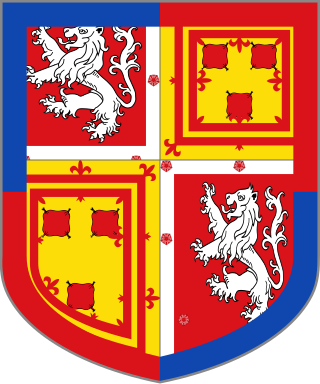
The Dunbar baronetcy of Northfield was created for William Dunbar of Hempriggs House, Caithness, on 10 April 1700. He had served as a Member of the Scottish Parliament for Caithness constituency.
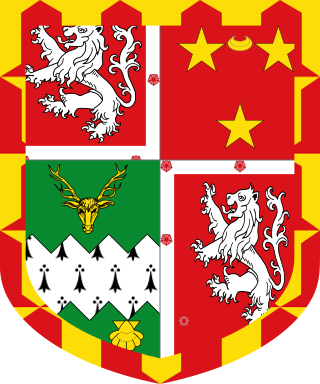
The Dunbar baronetcy of Hempriggs, Caithness, was created for Hon. James Dunbar, formerly James Sutherland, on 10 or 21 December 1706. He was a younger son of James Sutherland, 2nd Lord Duffus, and brother of the attainted Jacobite Kenneth Sutherland. He married Elizabeth Dunbar, daughter and heiress of Sir William Dunbar, 1st Baronet of the Dunbar baronets of Northfield (1700).

The Dunbar baronetcy of Boath, Nairn was created on 19 September 1814 in the Baronetage of the United Kingdom for the naval captain Sir James Dunbar, knighted in 1809 or 1810.